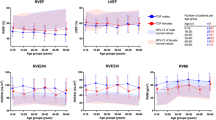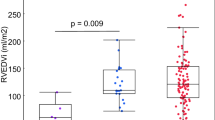Abstract
The timing of pulmonary valve replacement (PVR) in asymptomatic patients with repaired tetralogy of Fallot (TOF) is typically based on cardiac magnetic resonance imaging-derived ventricular volume measurements. Current criteria do not account for sex-based differences in chamber size. The purpose of this study was to compare male and female ventricular volumes and function in TOF patients with a hypothesis that females are less likely to meet common-indexed right ventricular end-diastolic volume (RVEDVi) and right ventricular end-systolic volume (RVESVi) criteria for PVR. Cardiac magnetic resonance data from 17 females (age 31.7 ± 15.4 years) and 23 males (30.7 ± 15.4 years) with TOF were retrospectively analyzed. Demographic and imaging data were recorded. Differences in sex-based means and standard deviations were evaluated using the Wilcoxon rank-sum test with continuity correction. Age and pulmonary regurgitant fraction were similar in females and males. RVEDVi was lower in females than in males, but the difference was not statistically significant. Differences in RVESVi, LVEDVi, LVESVi, and left ventricular ejection fraction were statistically significant, while the difference in right ventricular ejection fraction was not. RVEDVi was greater than 150 mL/m2 in 3/17 (17.6%) females and 10/23 (43.5%) males (OR 3.6). RVESVi was greater than 82 mL/m2 in 2/17 females and 8/23 males (OR 4.0). Sex-specific differences in right ventricular and left ventricular volumes and function are present in patients with TOF despite similar pulmonary regurgitation. These differences may need to be considered when evaluating patients for PVR.


Similar content being viewed by others
References
Kawel-Boehm N, Maceira A, Valsangiacomo-Buechel ER, Vogel-Claussen J, Turkbey EB, Williams R, Plein S, Tee M, Eng J, Bluemke DA (2015) Normal values for cardiovascular magnetic resonance in adults and children. J Cardiovasc Magn Reson 17:29. https://doi.org/10.1186/s12968-015-0111-7
Mooij CF, de Wit CJ, Graham DA, Powell AJ, Geva T (2008) Reproducibility of MRI measurements of right ventricular size and function in patients with normal and dilated ventricles. J Magn Reson Imaging 28(1):67–73. https://doi.org/10.1002/jmri.21407
Gnanappa GK, Rashid I, Celermajer D, Ayer J, Puranik R (2017) Reproducibility of cardiac magnetic resonance imaging (CMRI)-derived right ventricular parameters in repaired tetralogy of fallot (ToF). Heart Lung Circ. https://doi.org/10.1016/j.hlc.2017.04.017
Sievers B, Kirchberg S, Bakan A, Franken U, Trappe HJ (2004) Impact of papillary muscles in ventricular volume and ejection fraction assessment by cardiovascular magnetic resonance. J Cardiovasc Magn Reson 6(1):9–16
Winter MM, Bernink FJ, Groenink M, Bouma BJ, van Dijk AP, Helbing WA, Tijssen JG, Mulder BJ (2008) Evaluating the systemic right ventricle by CMR: the importance of consistent and reproducible delineation of the cavity. J Cardiovasc Magn Reson 10:40. https://doi.org/10.1186/1532-429X-10-40
Maceira AM, Prasad SK, Khan M, Pennell DJ (2006) Reference right ventricular systolic and diastolic function normalized to age, gender and body surface area from steady-state free precession cardiovascular magnetic resonance. Eur Heart J 27(23):2879–2888. https://doi.org/10.1093/eurheartj/ehl336
Alfakih K, Plein S, Thiele H, Jones T, Ridgway JP, Sivananthan MU (2003) Normal human left and right ventricular dimensions for MRI as assessed by turbo gradient echo and steady-state free precession imaging sequences. J Magn Reson Imaging 17(3):323–329. https://doi.org/10.1002/jmri.10262
Sarikouch S, Peters B, Gutberlet M, Leismann B, Kelter-Kloepping A, Koerperich H, Kuehne T, Beerbaum P (2010) Sex-specific pediatric percentiles for ventricular size and mass as reference values for cardiac MRI: assessment by steady-state free-precession and phase-contrast MRI flow. Circ Cardiovasc Imaging 3(1):65–76. https://doi.org/10.1161/CIRCIMAGING.109.859074
Maffessanti F, Muraru D, Esposito R, Gripari P, Ermacora D, Santoro C, Tamborini G, Galderisi M, Pepi M, Badano LP (2013) Age-, body size-, and sex-specific reference values for right ventricular volumes and ejection fraction by three-dimensional echocardiography: a multicenter echocardiographic study in 507 healthy volunteers. Circ Cardiovasc Imaging 6(5):700–710. https://doi.org/10.1161/CIRCIMAGING.113.000706
Geva T (2011) Repaired tetralogy of Fallot: the roles of cardiovascular magnetic resonance in evaluating pathophysiology and for pulmonary valve replacement decision support. J Cardiovasc Magn Reson 13:9. https://doi.org/10.1186/1532-429X-13-9
Buechel ER, Dave HH, Kellenberger CJ, Dodge-Khatami A, Pretre R, Berger F, Bauersfeld U (2005) Remodelling of the right ventricle after early pulmonary valve replacement in children with repaired tetralogy of Fallot: assessment by cardiovascular magnetic resonance. Eur Heart J 26(24):2721–2727. https://doi.org/10.1093/eurheartj/ehi581
Oosterhof T, van Straten A, Vliegen HW, Meijboom FJ, van Dijk AP, Spijkerboer AM, Bouma BJ, Zwinderman AH, Hazekamp MG, de Roos A, Mulder BJ (2007) Preoperative thresholds for pulmonary valve replacement in patients with corrected tetralogy of Fallot using cardiovascular magnetic resonance. Circulation 116(5):545–551. https://doi.org/10.1161/CIRCULATIONAHA.106.659664
Therrien J, Provost Y, Merchant N, Williams W, Colman J, Webb G (2005) Optimal timing for pulmonary valve replacement in adults after tetralogy of Fallot repair. Am J Cardiol 95(6):779–782. https://doi.org/10.1016/j.amjcard.2004.11.037
Lee C, Kim YM, Lee CH, Kwak JG, Park CS, Song JY, Shim WS, Choi EY, Lee SY, Baek JS (2012) Outcomes of pulmonary valve replacement in 170 patients with chronic pulmonary regurgitation after relief of right ventricular outflow tract obstruction: implications for optimal timing of pulmonary valve replacement. J Am Coll Cardiol 60(11):1005–1014. https://doi.org/10.1016/j.jacc.2012.03.077
Geva T (2013) Indications for pulmonary valve replacement in repaired tetralogy of fallot: the quest continues. Circulation 128(17):1855–1857. https://doi.org/10.1161/CIRCULATIONAHA.113.005878
Sarikouch S, Koerperich H, Dubowy KO, Boethig D, Boettler P, Mir TS, Peters B, Kuehne T, Beerbaum P, German Competence Network for Congenital Heart Defects I (2011) Impact of gender and age on cardiovascular function late after repair of tetralogy of Fallot: percentiles based on cardiac magnetic resonance. Circ Cardiovasc Imaging 4(6):703–711. https://doi.org/10.1161/CIRCIMAGING.111.963637
Warnes CA, Williams RG, Bashore TM, Child JS, Connolly HM, Dearani JA, del Nido P, Fasules JW, Graham TP Jr, Hijazi ZM, Hunt SA, King ME, Landzberg MJ, Miner PD, Radford MJ, Walsh EP, Webb GD, Smith SC Jr, Jacobs AK, Adams CD, Anderson JL, Antman EM, Buller CE, Creager MA, Ettinger SM, Halperin JL, Hunt SA, Krumholz HM, Kushner FG, Lytle BW, Nishimura RA, Page RL, Riegel B, Tarkington LG, Yancy CW, American College of C, American Heart Association Task Force on Practice G, American Society of E, Heart Rhythm S, International Society for Adult Congenital Heart D, Society for Cardiovascular A, Interventions, Society of Thoracic S (2008) ACC/AHA 2008 guidelines for the management of adults with congenital heart disease: a report of the American College of Cardiology/American Heart Association Task Force on Practice Guidelines (Writing Committee to Develop Guidelines on the Management of Adults With Congenital Heart Disease). Developed in Collaboration With the American Society of Echocardiography, Heart Rhythm Society, International Society for Adult Congenital Heart Disease, Society for Cardiovascular Angiography and Interventions, and Society of Thoracic Surgeons. J Am Coll Cardiol 52(23):e143–e263. https://doi.org/10.1016/j.jacc.2008.10.001
Fratz S, Chung T, Greil GF, Samyn MM, Taylor AM, Valsangiacomo Buechel ER, Yoo SJ, Powell AJ (2013) Guidelines and protocols for cardiovascular magnetic resonance in children and adults with congenital heart disease: SCMR expert consensus group on congenital heart disease. J Cardiovasc Magn Reson 15:51. https://doi.org/10.1186/1532-429X-15-51
Frigiola A, Tsang V, Bull C, Coats L, Khambadkone S, Derrick G, Mist B, Walker F, van Doorn C, Bonhoeffer P, Taylor AM (2008) Biventricular response after pulmonary valve replacement for right ventricular outflow tract dysfunction: is age a predictor of outcome? Circulation 118(14 Suppl):S182–S190. https://doi.org/10.1161/CIRCULATIONAHA.107.756825
Funding
None.
Author information
Authors and Affiliations
Corresponding author
Ethics declarations
Conflict of interest
The authors have no commercial or other associations that might pose a conflict of interest in connection with the submitted article. The authors of this work report no relationships with industry and other entities. The authors declare that they have no conflict of interest.
Ethical Approval
This retrospective research was approved by the University of Wisconsin Institutional Review Board, protocol 2016-0418.
Additional information
Publisher's Note
Springer Nature remains neutral with regard to jurisdictional claims in published maps and institutional affiliations.
Rights and permissions
About this article
Cite this article
Pettit, K.A., Francois, C.J., Aggarwal, N.R. et al. Sex-Specific Differences in Ventricular Dimensions in Repaired Tetralogy of Fallot: A Retrospective Study. Pediatr Cardiol 40, 1530–1535 (2019). https://doi.org/10.1007/s00246-019-02181-5
Received:
Accepted:
Published:
Issue Date:
DOI: https://doi.org/10.1007/s00246-019-02181-5




